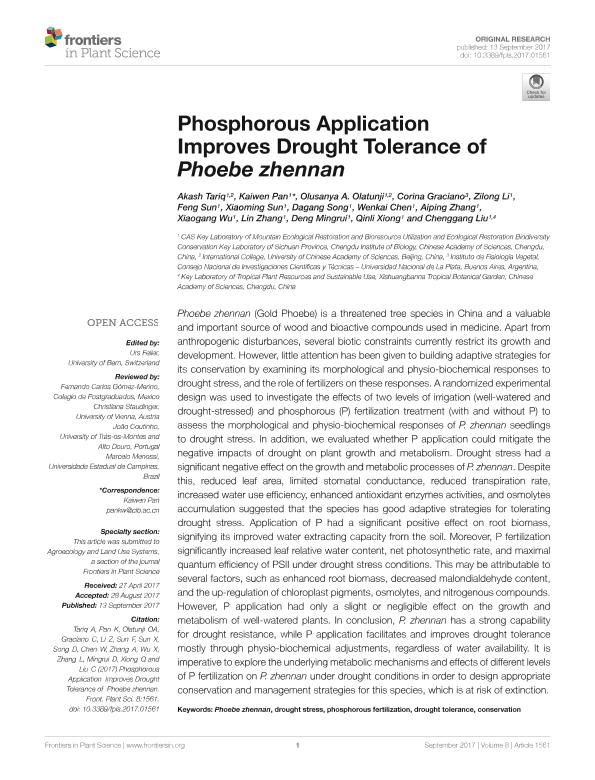Mostrar el registro sencillo del ítem
dc.contributor.author
Tariq, Akash
dc.contributor.author
Pan, Kaiwen
dc.contributor.author
Olatunji, Olusanya A.
dc.contributor.author
Graciano, Corina

dc.contributor.author
Li, Zilong
dc.contributor.author
Sun, Feng
dc.contributor.author
Sun, Xiaoming
dc.contributor.author
Song, Dagang
dc.contributor.author
Chen, Wenkai
dc.contributor.author
Zhang, Aiping
dc.contributor.author
Wu, Xiaogang
dc.contributor.author
Zhang, Lin
dc.contributor.author
Mingrui, Deng
dc.contributor.author
Xiong, Qinli
dc.contributor.author
Liu, Chenggang
dc.date.available
2021-01-25T16:44:29Z
dc.date.issued
2017-09
dc.identifier.citation
Tariq, Akash ; Pan, Kaiwen; Olatunji, Olusanya A. ; Graciano, Corina; Li, Zilong; et al.; Phosphorous application improves drought tolerance of phoebe zhennan; Frontiers Media S.A.; Frontiers in Plant Science; 8; 9-2017
dc.identifier.issn
1664-462X
dc.identifier.uri
http://hdl.handle.net/11336/123600
dc.description.abstract
Phoebe zhennan (Gold Phoebe) is a threatened tree species in China and a valuable and important source of wood and bioactive compounds used in medicine. Apart from anthropogenic disturbances, several biotic constraints currently restrict its growth and development. However, little attention has been given to building adaptive strategies for its conservation by examining its morphological and physio-biochemical responses to drought stress, and the role of fertilizers on these responses. A randomized experimental design was used to investigate the effects of two levels of irrigation (well-watered and drought-stressed) and phosphorous (P) fertilization treatment (with and without P) to assess the morphological and physio-biochemical responses of P. zhennan seedlings to drought stress. In addition, we evaluated whether P application could mitigate the negative impacts of drought on plant growth and metabolism. Drought stress had a significant negative effect on the growth and metabolic processes of P. zhennan. Despite this, reduced leaf area, limited stomatal conductance, reduced transpiration rate, increased water use efficiency, enhanced antioxidant enzymes activities, and osmolytes accumulation suggested that the species has good adaptive strategies for tolerating drought stress. Application of P had a significant positive effect on root biomass, signifying its improved water extracting capacity from the soil. Moreover, P fertilization significantly increased leaf relative water content, net photosynthetic rate, and maximal quantum efficiency of PSII under drought stress conditions. This may be attributable to several factors, such as enhanced root biomass, decreased malondialdehyde content, and the up-regulation of chloroplast pigments, osmolytes, and nitrogenous compounds. However, P application had only a slight or negligible effect on the growth and metabolism of well-watered plants. In conclusion, P. zhennan has a strong capability for drought resistance, while P application facilitates and improves drought tolerance mostly through physio-biochemical adjustments, regardless of water availability. It is imperative to explore the underlying metabolic mechanisms and effects of different levels of P fertilization on P. zhennan under drought conditions in order to design appropriate conservation and management strategies for this species, which is at risk of extinction.
dc.format
application/pdf
dc.language.iso
eng
dc.publisher
Frontiers Media S.A.

dc.rights
info:eu-repo/semantics/openAccess
dc.rights.uri
https://creativecommons.org/licenses/by-nc-sa/2.5/ar/
dc.subject
Conservation
dc.subject
Drought Stress
dc.subject
Drought Tolerance
dc.subject
Phoebe Zhennan
dc.subject
Phosphorous Fertilization
dc.subject.classification
Silvicultura

dc.subject.classification
Agricultura, Silvicultura y Pesca

dc.subject.classification
CIENCIAS AGRÍCOLAS

dc.title
Phosphorous application improves drought tolerance of phoebe zhennan
dc.type
info:eu-repo/semantics/article
dc.type
info:ar-repo/semantics/artículo
dc.type
info:eu-repo/semantics/publishedVersion
dc.date.updated
2018-10-22T22:33:25Z
dc.journal.volume
8
dc.journal.pais
Países Bajos

dc.description.fil
Fil: Tariq, Akash. Chinese Academy of Sciences; República de China
dc.description.fil
Fil: Pan, Kaiwen. Chinese Academy of Sciences; República de China
dc.description.fil
Fil: Olatunji, Olusanya A.. Chinese Academy of Sciences; República de China
dc.description.fil
Fil: Graciano, Corina. Consejo Nacional de Investigaciones Científicas y Técnicas. Centro Científico Tecnológico Conicet - La Plata. Instituto de Fisiología Vegetal. Universidad Nacional de La Plata. Facultad de Ciencias Naturales y Museo. Instituto de Fisiología Vegetal; Argentina
dc.description.fil
Fil: Li, Zilong. Chinese Academy of Sciences; República de China
dc.description.fil
Fil: Sun, Feng. Chinese Academy of Sciences; República de China
dc.description.fil
Fil: Sun, Xiaoming. Chinese Academy of Sciences; República de China
dc.description.fil
Fil: Song, Dagang. Chinese Academy of Sciences; República de China
dc.description.fil
Fil: Chen, Wenkai. Chinese Academy of Sciences; República de China
dc.description.fil
Fil: Zhang, Aiping. Chinese Academy of Sciences; República de China
dc.description.fil
Fil: Wu, Xiaogang. Chinese Academy of Sciences; República de China
dc.description.fil
Fil: Zhang, Lin. Chinese Academy of Sciences; República de China
dc.description.fil
Fil: Mingrui, Deng. Chinese Academy of Sciences; República de China
dc.description.fil
Fil: Xiong, Qinli. Chinese Academy of Sciences; República de China
dc.description.fil
Fil: Liu, Chenggang. Chinese Academy of Sciences; República de China
dc.journal.title
Frontiers in Plant Science
dc.relation.alternativeid
info:eu-repo/semantics/altIdentifier/doi/http://dx.doi.org/10.3389/fpls.2017.01561
dc.relation.alternativeid
info:eu-repo/semantics/altIdentifier/url/https://www.frontiersin.org/articles/10.3389/fpls.2017.01561/full
Archivos asociados
